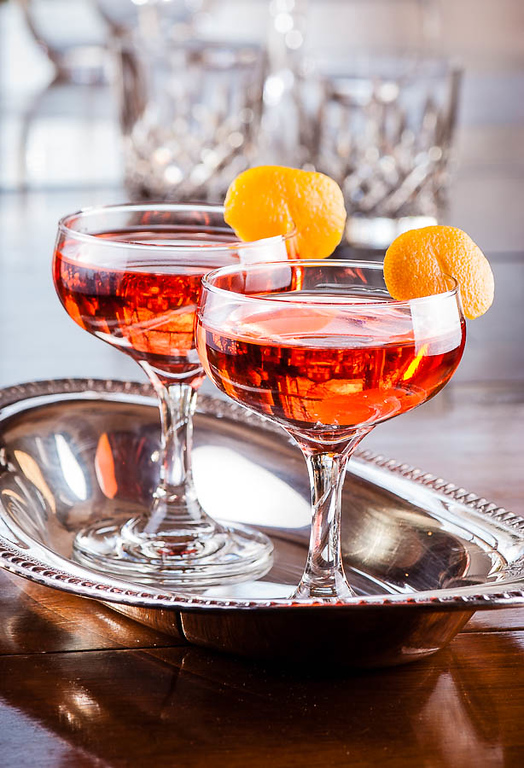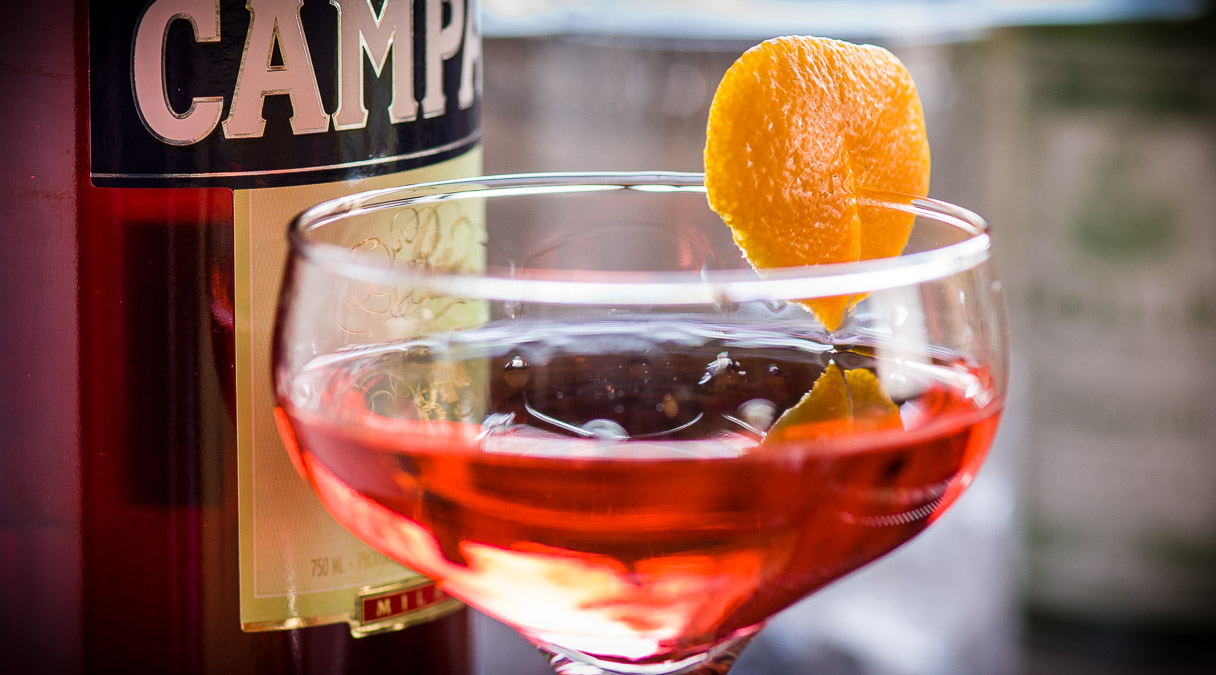The Lucien Gaudin Cocktail is a tribute to the skill and success of one of France’s national fencing champions. He first made his name in the very early twentieth century, went on to become European and world champion, then won two gold medals in the 1924 Olympics, and two more in 1928. A couple more silver medals made him one of the most decorated French medalists in the history of the Olympics.
The cocktail is a straightforward, “Frenchified” riff on the Negroni. It includes the Negroni’s gin and Campari, then substitutes dry vermouth and Cointreau for the original’s sweet vermouth.
It’s a clever substitution, and provides a version of the Negroni with adjustable sweetness and a pleasant emphasis on orange in the overall flavor. It makes an excellent aperitif cocktail.
The drink’s first maker is unknown, but it seems likely the Lucien Gaudin cocktail appeared while Gaudin was at the height of his fame and fencing prowess, in the late days of the Prohibition era—perhaps as early as 1928, while Gaudin would have been a hot item in the sporting news.
(I like to think it was invented by a Frenchman, but that’s probably just the Romantic in me, as Louis Renault might say. There’s no evidence.)

Update: Shortly after I published this article, Pavel Yan provided additional history (his comment is below). Pavel’s research indicates that the Lucien Gaudin was first published in Cocktails de Paris in 1929. That French compilation attributes the drink to “Charlie” of the “Cheval Pie.” Charlie did well with it—the Lucien Gaudin won the Coupe d’honneur at the 1929 French Professional Barmen’s Championship. And I still like to think Charlie was a Frenchman…
The earliest English listing I’ve seen for the Gaudin is Trader Vic’s 1948 Bartender’s Guide.
…the Lucien Gaudin remains obscure…
Even with Vic behind it, the Lucien Gaudin didn’t cause much of a stir; I haven’t seen it in cocktail manuals from the latter half of the century; Vic dropped it from his listings in the ’70s.
Even now, with renewed interest in cocktailing and cocktail history, the Lucien Gaudin remains obscure. It appears online occasionally, and has been listed in a small number of cocktail manuals since 2000 (notably in Robert Hess’s Essential Bartender’s Guide), but it has never achieved anything like the visibility you’d expect of a first-rate Negroni riff. It’s inexplicable.
Here’s how it’s made:
The Lucien Gaudin Cocktail
- 1½ oz dry gin (Tanqueray)
- ½ oz Campari
- ½ oz dry vermouth (Dolin Dry)
- ½ oz Cointreau
Stir all ingredients with ice. Strain into a chilled cocktail stem. Express and garnish with orange peel.
Vic and Charlie’s version, at 3:1 gin to Campari, makes the Lucien Gaudin into a sort of gateway version of the Negroni. As a matter of fashion, it seems cocktail bloggers are currently fond of 2:1 proportions. It’s a mix that is worth a try if you’re inclined to experiment, but the original was clearly meant to be a more gin-heavy cocktail.
The idea behind the 3:1 proportions may have been an attempt to deal with the hazards of introducing newer drinkers to the Negroni’s aggressive flavors. For starters, it increases the gin portion to deemphasize the Campari.
Then it breaks out the Negroni’s sweet vermouth into the combination of herbal dry vermouth and sugary Cointreau, separating herbality from sweetness. All of the components of the drink become independently adjustable—you can add or subtract Cointreau according to the drinker’s tastes without altering the other flavor components of the cocktail. Genius.
How’s it taste? The Lucien Gaudin has an orange nose, with a bit of the gin’s juniper. The initial taste is a bit sweet, and still dominated by the gin. Campari balances the sweetness nicely in the middle taste, without being too bitter or herbal. Some of the sweetness returns in the swallow, and then there is Campari’s trademark long, slightly bitter aftertaste.
Lucien Gaudin v. the Negroni: Side by side, Lucien Gaudin and Negroni are very much alike. Your choice of vermouths will drive the comparison. In my case, I compared the Lucien Gaudin made according to the recipe listed above with an equal-parts Negroni made with Tanqueray and Carpano Antica. (And Campari, of course.) The two were strikingly similar. The LG was more flatly orange; the Negroni was a bit more complexly herbal, and very slightly more bitter—less so than you’d think, with it’s much larger proportion of Campari. The Carpano may not have been the best sweet vermouth for the comparison, as it brings along a lush vanilla note that sort of muddies the waters in a comparison, but the same could happen on the dry vermouth side, too.
All in all, the differences are pretty subtle.
In the end, the Lucien Gaudin is a first-rate aperitif cocktail, a remarkable clone of the Negroni, and a tribute to its unknown inventor’s understanding of vermouths and sweeteners. I hope that one day soon it shakes off its obscurity—it deserves a little bit of fame.
Salut, Lucien Gaudin!
“The Lucien Gaudin Cocktail” at cold-glass.com : All text and photos © 2014 Douglas M. Ford. All rights reserved.

Negroni riffs are always welcome. and this appears a very worthy riff
Thanks, I hope you enjoy it!
If ever that was a drink that deserved a sword pick through its garnish . . .
I wish I’d thought of that…
Never heard of a cocktail quite like this before, but I do love my campari – so it definitely is a recipe I need to try out. Have a feeling it will be a big hit in the upcoming Christmas period too.
If you’re a Campari drinker, Lucien Gaudin should go down very comfortably. Thanks for commenting!
It seems like a wonderful post 8) As a matter of fact, the first mention of the Lucien Gaudin appears to ‘Cocktails de Paris’ by R.I.P. (real name is Thenon, Georges Gabriel) (1929, France). Author notices that the cocktail was invented by a certain Charlie aka ” du Cheval Pie ” (or from ” du Cheval Pie “, it’s not so clearly). Besides, R.I.P. writes that the drink picked up the Honor Prize of Parisian Barmen Championship 1929. Therefore it must have been created in 1928-1929.
By the way, you can get acquainted with this charming old book on the EUVS site – http://www.euvs.org/en/collection/books .
Pavel, thank you, what a great find—and it clarifies some of the LG’s history. I will update the post shortly to include that information.
EUVS is a very interesting site—I hadn’t seen or heard of some of those books before, and I look forward to doing a little reading. (Cocktails de Paris will make my brain hurt, I haven’t done any extended reading in French for years.)
Thanks for taking time to share the link, and the history.
The Lucien Gaudin is not quite as flavorful as the Negroni, but it is lighter and more refreshing. I’m finding it to be particularly good after big heavy holiday meals. Thanks for another great post!
Lots more holiday meals to come, I’ll definitely keep it in mind. Thanks for the idea!
Gaz Regan, in his excellent book on the Negroni, says in his entry for the Lucien Gaudin that one of the owners of the Dead Rabbit in New York sent him a recipe for a drink called the Belfast Bastard, a variation of the LG that substitutes Combier Crème de Pamplemousse Rose liqueur for the Cointreau, increases the gin to 2 oz., and switches out the orange twist for (appropriately enough) a grapefruit twist. I’ve used Combier as a substitute for Cointreau in drinks calling for the latter, but I haven’t seen Crème de Pamplemousse. Are you familiar with it?
I wonder whether Charlie at the Cheval Pie in Paris knew Lucien Gaudin or just decided to honor his exploits by naming a cocktail after him. We’ll probably never know.
Pamplemousse. The French have such excellent words, and that one is an order of magnitude more fun to say than “grapefruit.”
Anyway, Combier doesn’t seem to distribute their products in my region. I’ve read good reports about the curacao you mention, but I had never even heard of their Crème de Pamplemousse Rose. It’s an intriguing idea for a product; I hope I get to try it someday. Perhaps in a Belfast Bastard, that would be nice.
I’d like to think that Charlie met Gaudin one day, perhaps served him a cocktail; you’re right, we can’t know.
Thanks for bringing the word “Pamplemousse” to Cold Glass.
I just took a stab at this but didn’t have Campari so I had to reach for aparol and so instead of dry vermouth I swapped it out for Cocchi Americano. I think what resulted was lovely nonetheless. Thanks again Doug!
That sounds like a brilliant substitution, and I’m glad it worked out. It looks like the Cocchi Americano would add back a bit of the “edge” that’s lost moving from Campari to Aperol. Great idea, and I’ll remember it in the future. Thanks!
It makes my wife happy every time I mix it. She is devoted Negroni aficionado but always keen to try Negroni riffs. We both enjoy your blog, thank you for all investigations and suggestions
Rok, that’s uplifting news, thanks for letting me know, and thanks for reading Cold Glass.